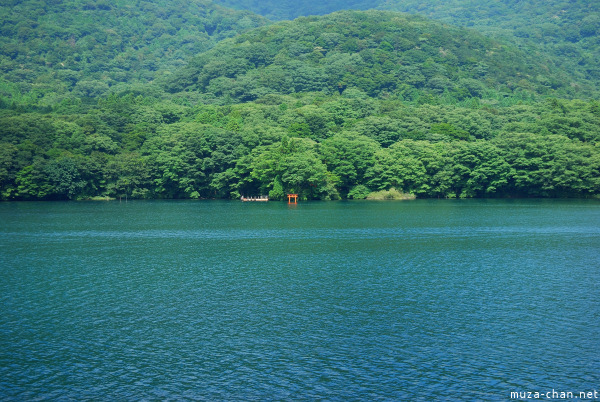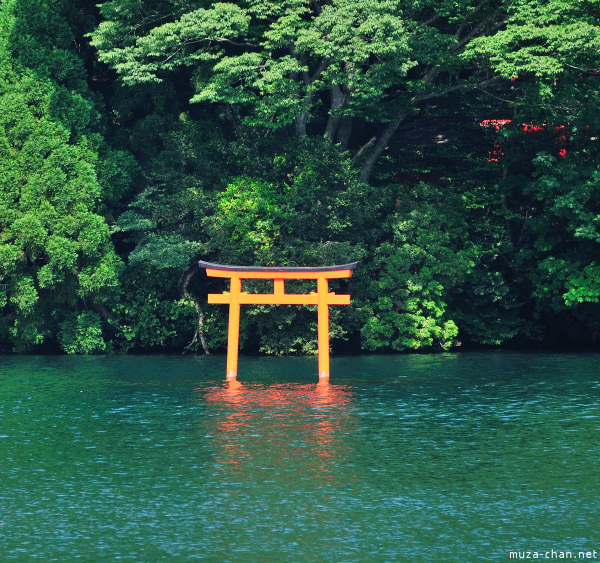Besides the well-known red torii of the Hakone Shrine, in the Lake Ashi there is another, smaller torii, which belongs to the Kuzuryu Shrine.
There is an old Japanese story related to this Shrine, that caught my attention because it is about an evil dragon, something unusual for the East Asian mythology.
The legend says that, during the Nara period, a fierce nine-headed dragon settled in the Lake Ashi and demanded to the villagers human sacrifices, a young girl every year.
Hearing this, a priest named Mangan came and exorcised the dragon and chained him to an underwater rock.
In time, the dragon reformed himself and became worshipped as Kuzuryū Daimyōjin (九頭竜大明神, “Great God Nine-Headed Dragon"). Consequently, the priest built a shrine to the dragon, where the offerings changed from human sacrifice to steamed rice with red beans.
Since then, the dragon became the guardian spirit of the Lake Ashi.

The legend is very much similar to the European legends, where the dragon is usually a malevolent being. In the Romanian tales, there is a similar being called “balaur“, with 3, 7 or 12 heads, that also asks human sacrifices, usually young girls or princesses.
In the contrast, the dragons from the East Asian mythology are benevolent beings, associated with the water and frequently depicted surrounded by clouds, controlling the wind and the water.
However, it is noteworthy that unlike the Western legends, even this Japanese legend has a happy-ending for the dragon. :)
În afară de cunoscutul torii roşu al altarului Hakone, în lacul Ashi se mai află un torii mai mic, care aparţine altarului Kuzuryu.
Există o legendă interesantă legată de acest altar, care mi-a atras atenţia în primul rând datorită faptului că este despre un dragon malefic.
Legenda spune ca în perioada Nara, un dragon feroce cu nouă capete s-a stabilit în lacul Ashi şi le-a cerut locuitorilor din apropiere să-i aducă în fiecare an câte o fată, ca sacrificiu.
Auzind acest lucru, un preot pe nume Mangan a venit şi a exorcizat dragonul, legîndu-l de o piatră subacvatică.
În final, dragonul s-a îmbunat şi a devenit venerat ca Kuzuryū Daimyōjin (九頭竜大明神, “Great God Nine-Headed Dragon"). Ca urmare, preotul i-a ridicat un altar unde, în locul sacrificiilor umane, i-au adus ca ofrande orez şi fasole roşie.
De atunci, dragonul a devenit gardianul lacului.

Legenda seamănă mult cu cele europene, unde dragonul este, de obicei, o fiinţă malefică. În basmele româneşti există o fiinţă asemănătoare, balaurul, care are mai multe capete (3, 7 sau 12) şi care le cere oamenilor să-i aducă ca sacrificiu fecioare, sau care răpeşte prinţese. În mitologia chineză şi japoneză, dragonul este o fiinţă benefică, legată de apă, reprezentat de multe ori înconjurat de nori, care controlează norii, vântul şi ploaia.
Totuşi, trebuie remarcat că spre deosebire de legendele vestice, legenda japoneză are un final fericit pentru dragon. :)



